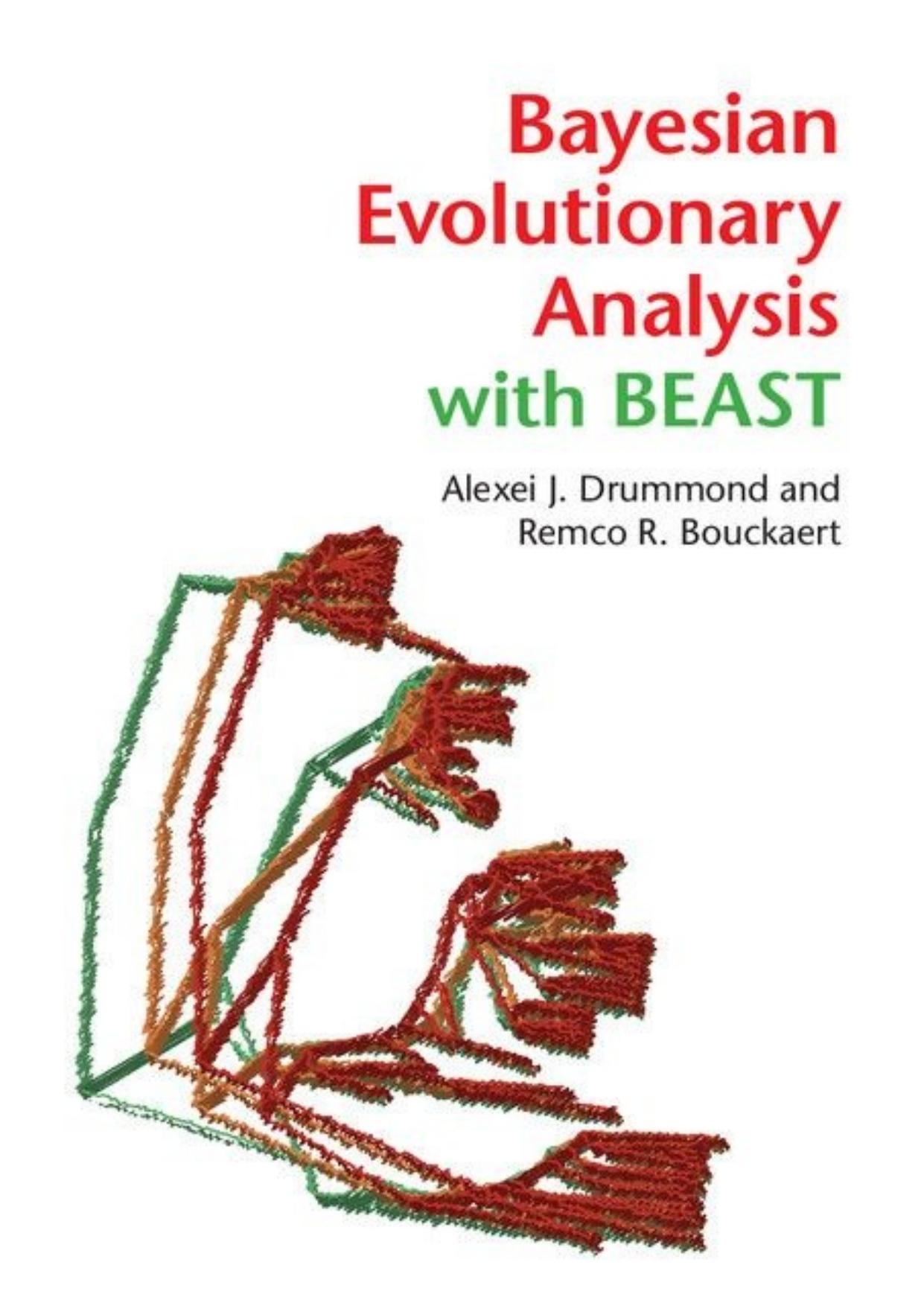Bayesian Evolutionary Analysis with BEAST by Alexei J. Drummond & Remco R. Bouckaert

Author:Alexei J. Drummond & Remco R. Bouckaert [Drummond, Alexei J.]
Language: eng
Format: azw3, pdf
Publisher: Cambridge University Press
Published: 2015-08-05T16:00:00+00:00
9.3.1Some demographic reconstruction issues to be aware of
A BSP or EBSP reconstruction typically shows 95% HPD intervals that (going back into the past) can remain constant in both estimated population size and its uncertainty for a large portion at the end of the plot. Intuitively, one would expect the uncertainty in the estimate to increase going back in time since the further one goes back in time the more distant we are from the sampled data (when there is no calibration information). This holds especially for the the oldest part of the plot.
However, the reason these HPD intervals do not behave as expected is that the boundaries of the underlying piecewise-constant population function coincide with coalescent events (by design). If instead the boundaries were chosen to be equidistant, then the expected increase in uncertainty going back towards the root would occur because on average there would be fewer coalescent events in intervals that are nearer to the root and the estimated times of those coalescent events nearer the root would also be more uncertain. However, because of the designed coincidence of population size changes at coalescent events in the BSP and EBSP, the number of coalescent events per interval (i.e. the amount of information available to estimate population size per interval) is a priori equal across intervals. So in (E)BSP models, uncertainty in population size is traded for a loss of resolution in the timing of population size changes (since the underlying population size can typically only change at wide intervals near the root of the tree).
Note that this modelling choice is different from that used in the birth–death skyline plot (Stadler et al. 2013), in which the piecewise function is chosen to have changes at regularly spaced intervals. Consequently, (net) birth rates reconstructed through time using the birth–death skyline model tend to show 95% HDP intervals that grow larger the further one goes back in time.
It is sometimes the case that a horizontal line can be drawn through the 95% HPD intervals of the resulting BSP. This doesn’t mean that the reconstruction is consistent with a constant population size. A better way to decide whether there is a trend in population size is to count the fraction of trees in the posterior sample that suggest a trend. For example, if more than 95% of the posterior samples describe a skyline plot where the population size at the root is smaller than at the tips, then a growing population size can be inferred. In the case of EBSP, a more direct test is simply to calculate the posterior probability that there is more than one piece in the population size function.
One of the reasons that a demographic reconstruction can come with large 95% HPD intervals suggesting large uncertainty in population sizes is due to uncertainty in the molecular clock rate. Figure 9.4 shows the effect of having low uncertainty in the relative divergence times, but large uncertainty in the overall molecular clock rate. If only trees corresponding to low molecular
Download
Bayesian Evolutionary Analysis with BEAST by Alexei J. Drummond & Remco R. Bouckaert.pdf
This site does not store any files on its server. We only index and link to content provided by other sites. Please contact the content providers to delete copyright contents if any and email us, we'll remove relevant links or contents immediately.
| Fossils | Game Theory |
| Genetics | Molecular Biology |
| Organic | Paleontology |
Sapiens: A Brief History of Humankind by Yuval Noah Harari(14322)
Sapiens by Yuval Noah Harari(5328)
Pale Blue Dot by Carl Sagan(4960)
Homo Deus: A Brief History of Tomorrow by Yuval Noah Harari(4874)
Livewired by David Eagleman(3730)
Origin Story: A Big History of Everything by David Christian(3666)
Brief Answers to the Big Questions by Stephen Hawking(3394)
Inferior by Angela Saini(3295)
Origin Story by David Christian(3170)
Signature in the Cell: DNA and the Evidence for Intelligent Design by Stephen C. Meyer(3103)
The Gene: An Intimate History by Siddhartha Mukherjee(3076)
The Evolution of Beauty by Richard O. Prum(2966)
Aliens by Jim Al-Khalili(2804)
How The Mind Works by Steven Pinker(2784)
A Short History of Nearly Everything by Bryson Bill(2666)
Sex at Dawn: The Prehistoric Origins of Modern Sexuality by Ryan Christopher(2500)
From Bacteria to Bach and Back by Daniel C. Dennett(2463)
Endless Forms Most Beautiful by Sean B. Carroll(2447)
Who We Are and How We Got Here by David Reich(2418)
